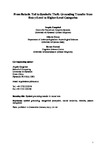From robotic toil to symbolic theft: Grounding transfer from entry-level to higher-level categories
| dc.contributor.author | Cangelosi, A | en |
| dc.contributor.author | Greco, A | en |
| dc.contributor.author | Harnad, S | en |
| dc.date.accessioned | 2015-10-13T21:04:23Z | |
| dc.date.available | 2015-10-13T21:04:23Z | |
| dc.date.issued | 2000-01-01 | en |
| dc.identifier.issn | 0954-0091 | en |
| dc.identifier.uri | http://hdl.handle.net/10026.1/3618 | |
| dc.description.abstract |
Neural network models of categorical perception (compression of within-category similarity and dilation of between-category differences) are applied to the symbol-grounding problem (of how to connect symbols with meanings) by connecting analogue sensorimotor projections to arbitrary symbolic representations via learned category-invariance detectors in a hybrid symbolic/non-symbolic system. Our nets are trained to categorize and name 50 × 50 pixel images (e.g. circles, ellipses, squares and rectangles) projected on to the receptive field of a 7 × 7 retina. They first learn to do prototype matching and then entry-level naming for the four kinds of stimuli, grounding their names directly in the input patterns via hidden-unit representations ('sensorimotor toil'). We show that a higher-level categorization (e.g. 'symmetric' versus 'asymmetric') can be learned in two very different ways: either (1) directly from the input, just as with the entry-level categories (i.e. by toil); or (2) indirectly, from Boolean combinations of the grounded category names in the form of propositions describing the higher-order category ('symbolic theft'). We analyse the architectures and input conditions that allow grounding (in the form of compression/ separation in internal similarity space) to be 'transferred' in this second way from directly grounded entry-level category names to higher-order category names. Such hybrid models have implications for the evolution and learning of language. | en |
| dc.format.extent | 143 - 162 | en |
| dc.language.iso | en | en |
| dc.title | From robotic toil to symbolic theft: Grounding transfer from entry-level to higher-level categories | en |
| dc.type | Conference Contribution | |
| plymouth.issue | 2 | en |
| plymouth.volume | 12 | en |
| plymouth.publication-status | Published | en |
| plymouth.journal | Connection Science | en |
| dc.identifier.doi | 10.1080/09540090050129763 | en |
| plymouth.organisational-group | /Plymouth | |
| plymouth.organisational-group | /Plymouth/Faculty of Science and Engineering | |
| plymouth.organisational-group | /Plymouth/Research Groups | |
| plymouth.organisational-group | /Plymouth/Research Groups/Institute of Health and Community | |
| plymouth.organisational-group | /Plymouth/Research Groups/Marine Institute | |
| dc.rights.embargoperiod | Not known | en |
| rioxxterms.versionofrecord | 10.1080/09540090050129763 | en |
| rioxxterms.licenseref.uri | http://www.rioxx.net/licenses/all-rights-reserved | en |
| rioxxterms.type | Conference Paper/Proceeding/Abstract | en |


